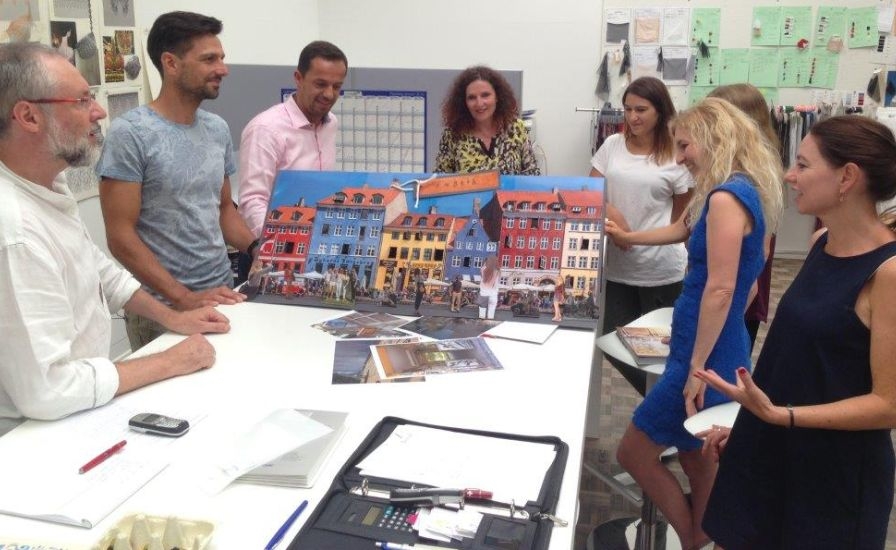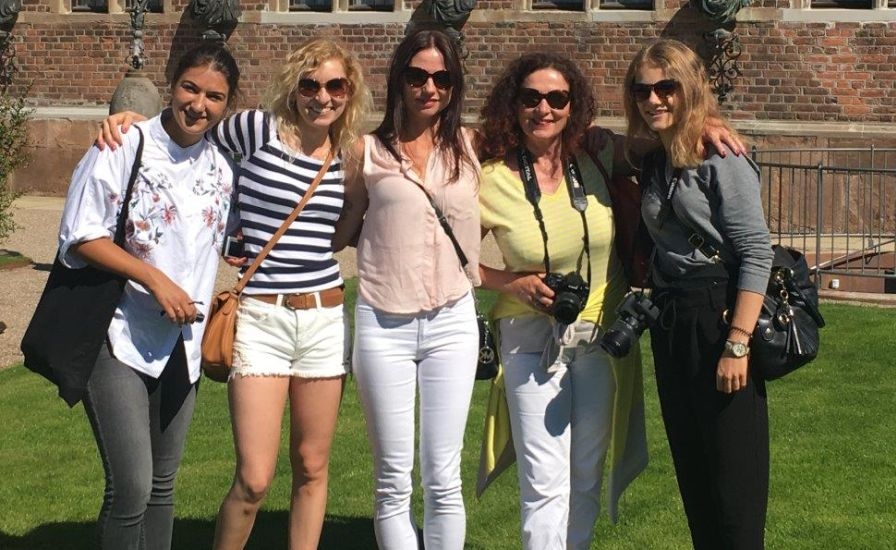
Intima Asia
Bischoff Fashion Forward
22 February 2017
Founded in 1927, Swiss embroiderer Bischoff Textil will celebrate its milestone 90th anniversary in 2017.
A darling of haute couture and premium lingerie and outerwear designers, Bischoff is far from resting on its laurels, especially since the arrival of David Rygula as COO. We spoke to David to learn more about the company's exciting and innovative plans.

Bischoff Textil is renowned for its sumptuous embroideries, such as the stunning stitches that bedecked Amal Clooney's Oscar de la Renta wedding gown. Its clients include elite global brands such as Armani, Alexander McQueen, Chanel, and Gucci, along with the world's leading lingerie labels, including Chantelle, Hanro, Aimer, Passionata and Wacoal.
In October 2015, Bischoff named a new four-man Executive Board: CEO Andreas Hungerbühler, a member of the owning family; CFO Thomas Neff; CTO Wolfgang Keller; and David Rygula as COO. All members of the team were long-term Bischoff employees, save Rygula, who came on board after a long management career in retail, wholesale, logistics, IT and product management for major international companies such as Tommy Hilfiger, Joop! and Victorinox.
The young, dynamic Executive Board got down to immediately implementing sweeping, revolutionary changes throughout the company at dizzying, breakneck speed, which influenced all aspects of the firm, from design to production and beyond.
Design and Inspiration: Thinking Outside the Box
"Bischoff is really a very exciting company, with a great heritage and absolutely great products. Unfortunately, we were no longer "hot," but rather dusty and too expensive, something which our customers also told us. We were not able to act competitively enough. Making Bischoff great and competitive again were the main cornerstones of my work during my first year as COO of Bischoff Textil," explained David Rygula.
One of the most urgent changes to the company regarded the way their very talented designers worked independently from one another on future collections, leading to the lack of a common thread among its three themes – romantic, graphic and opulent. In order to tackle this, the design team now travels to a city for two-to-four days in order to take in its history and culture and create a cohesive collection. Their first trip to Lisbon, in January 2016, centered around the themes ceramics, graffiti, and flowers. In August, a journey to Copenhagen inspired the themes architecture, bridges and jewellery.
These jaunts are not only stimulating, but help build teamwork and collaboration, allowing the design team to discuss colours and ideas while wandering through the streets of the destination city. Creativity is given room to blossom not only through taking in visual sensations and history, but through sharing laughter during work hours or over an evening meal.
Additionally, the artistic team is inspired by images from nature, museum visits, fashion events, and the hand-made embroidery traditions of Switzerland. Bischoff's headquarters in St. Gallen – one of the most famous centers for textiles and embroidery in the world – houses one of the largest private embroidery collections in Europe, and is actively used by the art department and the company's customers.
Bischoff's team still sketches each design by hand with charcoal, before transferring the motifs to computer, ensuring a human, organic touch to each style.
Moreover, Bischoff is dedicated to seeking exciting, new uses for embroidery beyond clothing and lingerie that push existing boundaries of creativity. As David notes, "Embroidery is an insanely beautiful product that offers a large amount of versatile possibilities." For example, the company collaborated on an embroidered face and strap for the Swiss luxury watchmaker, Hublot, as well as an embroidery-embedded vitrine window for a local glassmaker.

Cost-Efficiency and Competitiveness
Along with the elegance of their designs, the company is equally noted for quality and innovation. They are continually investing in new technology and improving the manufacturing process. They use the same machines across all manufacturing facilities, so that they can easily and quickly respond to their clients' needs by switching production from one factory to another.
Bischoff maintains a factory in Switzerland where they produce for both lingerie and outerwear. Rygula underscores the importance of maintaining this local facility as a sustainable location; it guarantees fast service, high quality, and top customer service. Moreover, the know-how of these long-term Swiss workers is indispensible to the company's success. Bischoff is dedicated to creating the most affirmative environment possible for its employees, and has made improvements to ensure a comfortable, modern workplace.
Just like the design process, the new Executive Board of Bischoff has created an entirely new supply chain set-up with a revised infrastructure. While the company also maintains facilities in Thailand, Turkey and Sri Lanka, it has recently entered into partnership with Oriental Embroidery, based in Zengcheng, Mainland China. Oriental Embroidery was founded in 1990 by a Taiwanese professional team with over 20 years experience in embroidery techniques and business management, and has since grown to become the largest lace manufacturer in China. The company annually upgrades its fleet with the latest Japanese and Swiss machinery, ensuring the same high quality that Bischoff demands.
Thanks to this improved, efficient and cost-effective new supply chain, Bischoff is able to provide their customers with several options in terms of quality and price, thereby making the company competitive in a wide variety of world markets and bringing Bischoff quality and design to a wider range of partners and clients.
Launch of a New Diffusion Line: Essentials for Outerwear
While Bischoff has had the lower-priced Essentials line for lingerie for many years, starting in October 2016, the company began the rollout of its new diffusion line, Essentials for Outerwear, which can also be used in lingerie. The company plans to expand this line in the future.
Essentials offers high quality in a contemporary way. This less expensive solution will reach clients that were priced out of Bischoff's luxury couture offerings, including premium and commercial customers like Zara, H&M, and Marks & Spencer. This collection can be ordered either from the production site in Switzerland or from the company's new location in China.

Corporate Identity: More Than Just A Logo
To
mirror the myriad of new changes currently being undertaken by the
company, Bischoff has also completely revamped its corporate identity,
including its website, marketing tools, brochures, company profiles,
lookbooks, and trendbooks, as well as buying and refurbishing its own
stand at the Interfilière trade show, to name a few. The new identity
shows a company that is clearly rejuvenated and thoroughly modern.
At
the same time, Bischoff gave a makeover to the entrance area of its
corporate headquarters in Switzerland. David Rygula explained that the
area "did not have the character of Bischoff being a textile company.
There was clearly no emotion, which is important in the textile sector."
The new entrance area has been transformed into a type of living room,
outfitted with Bischoff fabrics.
Additionally, starting in January
2017, Bischoff is taking on a new agent for lingerie and outerwear in
France, Olivier Encontre of Transversal Agence. It also is working with
celebrities such as St. Gallen native, Tanja La Croix, who is a famous
Swiss model and "DJane."
Celebrating 90 Years
Bischoff
celebrates its 90th anniversary in 2017. The company has been able to
thrive for almost a century due to its established values and
traditions, combined with its capacity to take risks and innovate. This
ability to constantly adapt to market forces gives the company an edge
in a fashion scene that is increasingly fast.
David Rygula
elaborates on Bischoff's unique secret to success, "We are not only
'fashion.' We are a company that believes and keeps their heritage and
traditions, but with a new twist. We combine 90 years of tradition and
know-how with a new and modern setup. This demands thinking outside the
box, doing things we never did before, trial and error, but also being
able to make mistakes."
From the Cradle of Modern Embroidery
Bischoff is located in the northeastern Swiss city of St. Gallen, which established itself as a European center of quality textile production as early as the 15th century. In the mid-1800s, however, the region's focus shifted to embroidery when local resident, Isaac Groebli, inspired by the mechanics of the recent Singer sewing machine, invented an entirely new form of embroidery device which used a shuttle containing a bobbin of thread and a continuously threaded needle, called the Schiffli, which means "little boat" in Swiss German dialect, after the shape of the shuttle. Soon after, Groebli's eldest son devised a Jacquard system of punched cards to fully automate the process. By the early years of the 20th century, over half the world's embroidery originated in St. Gallen.
Swiss embroidery had a profound impact on the New World, as well. In the US, the first commercial embroidery company was founded by the Swiss Jacob Schiess; the industry thrived through the hard work of Swiss immigrants in the New York and New Jersey region, who worked on imported St. Gallen machines. The outbreak of World War 1 had a profound impact on trade, including St. Gallen embroidery. The years of greatest crisis for Swiss embroidery, however, were in the 1920s and 30s, when production plummeted and overall employment in the sector fell by 65%. It is in this climate that Bischoff Textil was launched in1927 at the nadir of Swiss embroidery output. Unlike other competitors at the time, Bischoff thrived due to its ingenuity, ability to hone in on niche sectors and the clever expansion of its product range – characteristics that propel the brand to success even today.
Copyright 2024. All rights reserved - Terms










